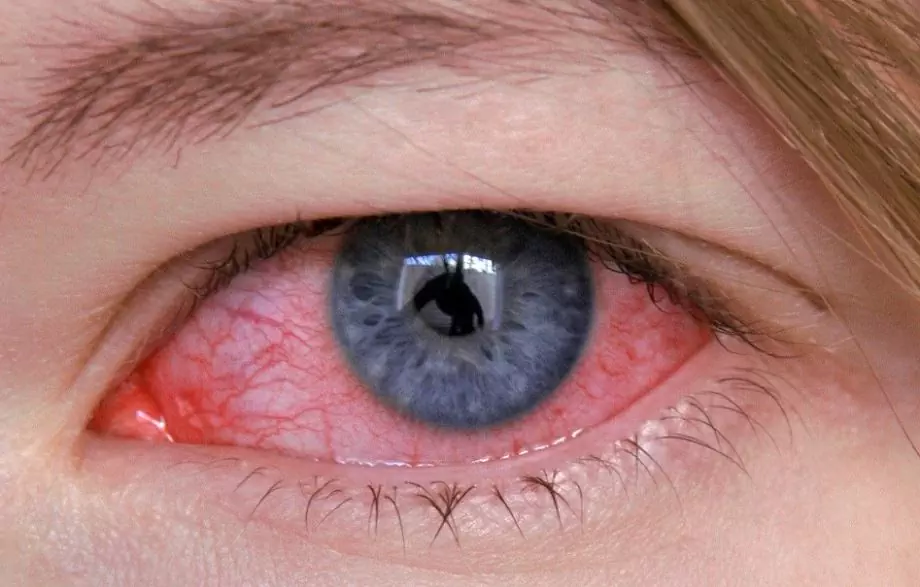- Author Rachel Wainwright [email protected].
- Public 2023-12-15 07:39.
- Last modified 2025-11-02 20:14.
Conjunctivitis

Conjunctivitis or pink eye disease is usually called inflammation of the conjunctiva. This is the name of the outer thin shell that covers the sclera and the inner surface of the eyelid.
Conjunctivitis is a fairly common ophthalmic pathology, the danger of which is often underestimated. A common cause of conjunctivitis in children is getting the infection directly into the eyes with dirty hands. Conjunctivitis in children is also caused by vitamin deficiencies, allergic reactions and chronic rhinitis with concomitant inflammation in the sinuses.
In adults, the most common cause of conjunctivitis is considered to be working under prolonged exposure to dust, chemicals or aerosols. Conjunctivitis can also be provoked by metabolic disorders in the body, eyelid diseases, for example, meibomitis or blepharitis, refractive pathologies: myopia, hyperopia, astigmatism, etc.
Conjunctivitis symptoms
The symptoms of conjunctivitis include the patient's complaints of a feeling of pain or itching in the eyes. Patients with symptoms of conjunctivitis often suffer from increased visual fatigue and photophobia. With a severe form of conjunctivitis, the symptoms of the disease are abundant purulent discharge from the eyes. With milder forms of conjunctivitis in children against the background of a cold, a limited manifestation of signs of inflammation is possible: lacrimation from the eyes and redness of the conjunctiva. In this case, you will need to first decide the question of how to cure a cold.
Types of conjunctivitis
Viral conjunctivitis is caused by all sorts of viral infections: adenoviral, coxaevirus or enterovirus. The bulk of all cases of viral conjunctivitis are diseases provoked by adenoviruses. Viral conjunctivitis of this type occurs, as a rule, against the background of an epidemic of adenovirus infection.
Hospital infection accounts for about 70% of the causes of viral conjunctivitis. It spreads mainly by contact and, much less often, by airborne droplets. Viral conjunctivitis affects both eyes of the patient. The incubation period lasts 4-8 days for adenoviral form of the disease and 4-48 hours for enteroviral form of viral conjunctivitis.
Diphtheria conjunctivitis or conjunctival diphtheria causes contact with the mucous membrane of the eye of a diphtheria bacillus. In addition to edema and redness of the eyelids, the symptoms of this type of conjunctivitis include the formation of specific gray films on the eyes. With the forced opening of the eyelid, purulent contents with flakes are poured out of the patient's eye.
Chlamydial conjunctivitis or chlamydia of the eye provokes infection with chlamydia. A special class of intracellular parasites can cause multiple damage to human organs, including the eyes. Specific symptoms of chlamydial conjunctivitis include the formation of follicles on the conjunctival fold, thickening and opacity of the cornea. In severe inflammation, the disease can lead to blindness.
Allergic conjunctivitis develops against the background of an allergic reaction of the mucous membrane of the eyes. It can be one of the forms of the body's reaction to a medicine, animal hair, pollen from certain plants, etc. Allergic conjunctivitis is always accompanied by allergic rhinitis, less often bronchial asthma or atopic dermatitis.
Pneumococcal conjunctivitis in children is often epidemic. It is manifested by the formation of punctate hemorrhages on the child's conjunctiva, the appearance of white-gray films on the loose surface of the eyelids. Pneumococcal conjunctivitis is virtually non-existent in adults.
The rarer types of conjunctivitis in children and adults include gonococcal, angular and autoimmune forms of the disease.
Conjunctivitis treatment

The tactics of treating conjunctivitis depends on the type of causative agent of the disease. With pneumococcal conjunctivitis in children, treatment consists of daily repeated washing of the eyes with antiseptic solutions. At the same time, the child is prescribed local antibiotic therapy in the form of eye drops. At night, an ointment based on Tetracycline or Erythromycin is placed under the eyelid of a patient with pneumococcal conjunctivitis.
Treatment of chlamydial conjunctivitis also involves rinsing the eyes with antiseptics and using antibiotics. But the main attention of the doctor is directed to the treatment of the main urogenital chlamydia. Surgical removal of follicles on the conjunctival fold of the eyelid is also possible.
The goal of treating conjunctivitis in children and adults against the background of a general allergic reaction is to reduce the body's sensitivity to the allergen. This condition is achieved by gradually administering small doses of the allergen to the patient. In acute allergic conjunctivitis, eye drops and ointments based on Glucocorticoids are used to relieve the patient's condition.
Treatment of conjunctivitis of the diphtheria form is carried out in the infectious diseases department with the indispensable introduction of anti-diphtheria serum to the patient.
Antiviral drugs, immunomodulators and vitamin therapy are an obligatory component of the treatment of viral conjunctivitis in children and adults.
Prevention of conjunctivitis
To prevent infection with conjunctivitis, the usual personal hygiene measures are often sufficient:
- to wash hands,
- do not rub your eyes with dirty hands,
- do not use someone else's cosmetics and towels,
- not wearing another person's contact lenses,
- after communicating with a patient with symptoms of conjunctivitis, wash your hands and drip your eyes with antimicrobial drops.
YouTube video related to the article:
The information is generalized and provided for informational purposes only. At the first sign of illness, see your doctor. Self-medication is hazardous to health!






